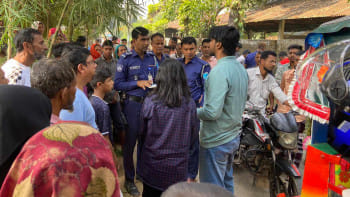Frustrated Nepal awaits new government

Landlocked Nepal's political uncertainty simply does not seem to end. The Federal Democratic Republic of Nepal held elections for the 275-seat Lower House of the Federal Parliament in two phases on November 26 and December 7, 2017. The results show that the Left Alliance made up of CPN-UML and CPN-MC swept the elections of the "Pratinidhi Sabha." The Alliance managed 174 seats (UML-121 and MC-53) in the House, which requires 138 seats for majority. The oldest party, Nepal Congress, garnered only 63 seats.
Nepal Election Commission will formally announce the election results after the Federal Parliament i.e. both Houses are duly constituted. The constitution requires that the new government can be sworn in only after the Federal Parliament is fully formed. Due to this technicality, the new government under the Left Alliance has not been ushered in. Thus, even after several weeks of the elections, the defeated Congress Chief Sher Bahadur Deuba is still holding on to power in Kathmandu as caretaker prime minister.
Curiously, as of the end of January 2018, the Upper House—the 59-seat Rashtriya Sabha—is yet to be constituted. One wonders why Deuba did not take steps to elect the Upper House soon after December 7. Two difficult obstacles are on the path for the new government to get into Singha Durbar (seat of the government).
First, Deuba has taken onto himself to constitute the Rashtriya Sabha before ceding power to the Left Alliance. Deuba said his government would step down after completing the transitional steps, without, of course, giving any time-frame. The Rashtriya Sabha will be elected by an electoral college comprised of 550 members of seven Provincial Assemblies, plus mayors and deputies of 753 local bodies. Though elections of all the Provincial Assemblies have been completed, they are yet to be convened, governments formed, governors appointed, and provincial capital designated. Completing these politico-administrative steps could take weeks, if not months.
Besides, the system of voting for the Upper House became contentious, delaying the Presidential ordinance on the mode of election, which is Single Transferable Voting (STV). Election is scheduled to be held on February 7.
Second, the Left Alliance is yet to merge together to become one party and decide on power sharing—in other words, how to split the spoils of office. Here the problem stems from the numbers each of the components have in the Alliance and self-assessment of its two leaders—UML's KP Oli and MC's PK Dahal. Who will head the merged party and who will become the prime minister? UML is dominant in the Left Alliance and wants to both head the merged party and retain the PM post for Oli. While, Dahal (Prachanda) wants the position of party chief and a rotating PM, so that he too can become PM.
Since there was no pre-election merger, the situation within the Left Alliance has become rather fluid. Post-election negotiations may not go Dahal's way. Dahal may not land the party chief's position given his numbers and also may not get to become PM. Oli seems likely to hold both posts. Dahal, who was in the outgoing coalition with Congress, summersaulted and joined UML, thereby losing credibility of a loyal partner. As of now, there is still no firm agreement between UML and MC on these critical issues. Though both are leftists, their political ideologies are different. There appears to be some mistrust between Oli and Dahal. The future of the Alliance seems uncertain, even before it has taken off.
Watching the confusion within the Alliance, Congress and other smaller parties are trying to take advantage of the situation. Congress supported by some Madhesi parties is offering Dahal a bait to become PM on a rotational basis. On the other hand, UML also has the option of forming a government with smaller parties offering carrots and retaining the bulk of positions for itself.
When the question about who will lead Nepal comes, the India factor also comes into play. Delhi wants whoever leads the next government to amend the 2015 constitution to accommodate the Madhesi (Indian-origin people living in Terai adjacent to Bihar) demands. India, angry with Nepal's 2015 Constitution, imposed a six-month blockade on the country in September 2015, which wreaked havoc on Nepal's economy.
Delhi's policy actually drove Oli, PM at that time, to Beijing's lap. That in turn prompted Delhi to back Deuba and Dahal to throw Oli out. If the past is any indicator, it is unlikely that Oli, seen as a genuine communist and a strong nationalist, will oblige Delhi. On the other hand, MC's Dahal, despite leading a Maoist insurgency and opposing the monarchy, is seen as pro-Indian and is generally sympathetic towards the demands of the Madhesis.
There is widespread frustration among the people that Deuba is holding the UML from forming the new government. People have taken to the streets in Kathmandu to demand Deuba government swiftly hand over power to the Left Alliance. Many believe that external forces are behind Deuba's conspiracies delaying the formation of the left government. Delhi seems genuinely worried about a left government under KP Oli for five years, more so because of the recent standoff with China at nearby Doklam.
Credit goes to the Nepal Election Commission for holding free and fair elections. Millions of frustrated Nepalese cast their votes hoping to get a stable, functional administration, not a turnstile that produced a PM almost every year since 2006. The constitution requires that the new Federal Parliament will sit by mid-January 2018, but that stipulation has already been breached.
Nepal has gone through a long constitutional transition. Whether the current deadlock will end by mid-February is the question. If the Left Alliance crumbles and fails to form a government, it would be a betrayal to the people of Nepal.
Mahmood Hasan is a former ambassador and secretary of the Bangladesh government.






Comments